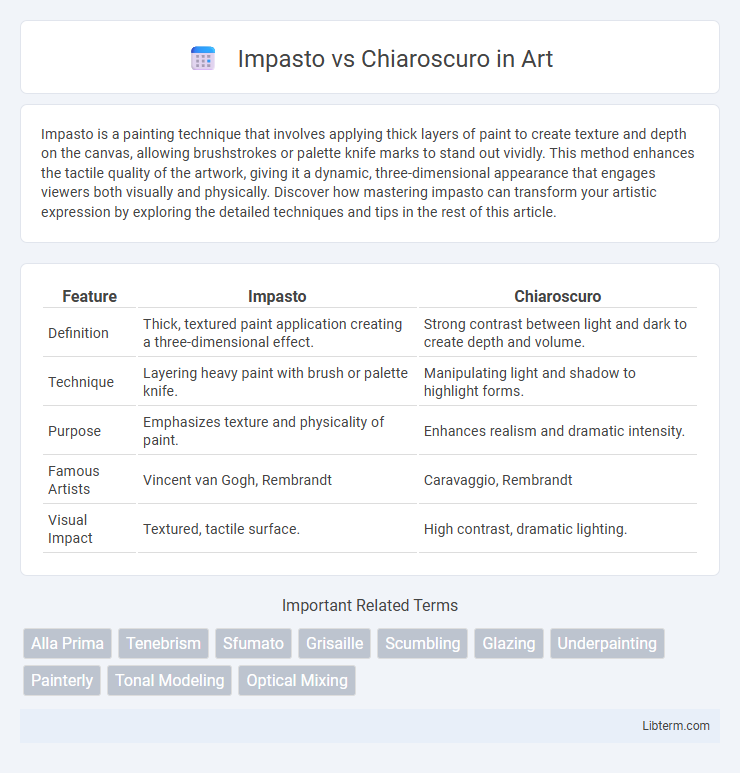Impasto is a painting technique that involves applying thick layers of paint to create texture and depth on the canvas, allowing brushstrokes or palette knife marks to stand out vividly. This method enhances the tactile quality of the artwork, giving it a dynamic, three-dimensional appearance that engages viewers both visually and physically. Discover how mastering impasto can transform your artistic expression by exploring the detailed techniques and tips in the rest of this article.
Table of Comparison
| Feature | Impasto | Chiaroscuro |
|---|---|---|
| Definition | Thick, textured paint application creating a three-dimensional effect. | Strong contrast between light and dark to create depth and volume. |
| Technique | Layering heavy paint with brush or palette knife. | Manipulating light and shadow to highlight forms. |
| Purpose | Emphasizes texture and physicality of paint. | Enhances realism and dramatic intensity. |
| Famous Artists | Vincent van Gogh, Rembrandt | Caravaggio, Rembrandt |
| Visual Impact | Textured, tactile surface. | High contrast, dramatic lighting. |
Introduction: Defining Impasto and Chiaroscuro
Impasto is a painting technique characterized by thickly applied paint that creates texture and depth on the canvas, enhancing light reflection and visual intensity. Chiaroscuro involves the strategic use of strong contrasts between light and dark to model three-dimensional forms and amplify dramatic effect. Both techniques originated in the Renaissance and remain fundamental in achieving dimensionality and emotional impact in visual art.
Historical Origins of Impasto and Chiaroscuro
Impasto, characterized by thick, textured paint application, originated during the Renaissance with artists like Titian and Rembrandt, who used it to create depth and drama in their works. Chiaroscuro, established in the same period, is a technique emphasizing strong contrasts between light and dark to model three-dimensional volume, pioneered by artists such as Leonardo da Vinci and Caravaggio. Both techniques revolutionized painting by enhancing realism and emotional intensity, shaping Western art history profoundly.
Key Characteristics of Impasto Technique
Impasto technique is characterized by thick, textured layers of paint applied with a palette knife or brush, creating a three-dimensional surface that catches light and adds depth to the artwork. This method emphasizes the physicality of paint, allowing brushstrokes and palette marks to become integral parts of the visual experience. Unlike chiaroscuro, which focuses on strong contrasts between light and dark to model forms, impasto highlights the tactile quality and expressive potential of paint texture itself.
Key Characteristics of Chiaroscuro Technique
Chiaroscuro is a painting technique characterized by the dramatic use of strong contrasts between light and shadow to create a sense of volume and three-dimensionality in subjects. It emphasizes gradations of tone, enhancing depth and realism, often employing a limited color palette dominated by dark hues and intense highlights. This technique is closely associated with Renaissance and Baroque artists such as Caravaggio and Rembrandt, who masterfully manipulated light to evoke mood and focus attention.
Notable Artists Using Impasto
Impasto, characterized by thick, textured paint application, was notably employed by Vincent van Gogh to convey emotional intensity and vivid movement in works like "Starry Night." Other prominent artists such as Rembrandt and Lucian Freud also utilized impasto to enhance depth and tactile quality in their portraits. This technique contrasts with chiaroscuro, which emphasizes strong light and shadow contrasts to create dramatic three-dimensional effects on flat surfaces.
Notable Artists Using Chiaroscuro
Caravaggio stands as the most renowned artist utilizing chiaroscuro, masterfully employing contrasts between light and dark to create dramatic intensity and three-dimensionality in his paintings. Rembrandt also significantly advanced chiaroscuro, using subtle gradations of shadow and light to enhance emotional depth and realism. In contrast, impasto emphasizes texture through thickly applied paint, as seen in works by Van Gogh, creating a tactile surface rather than focusing on light-shadow interplay.
Visual Impact: Texture vs. Light and Shadow
Impasto technique creates a striking visual impact by building thick layers of paint, adding tangible texture and depth that engage viewers through tactile intensity. Chiaroscuro emphasizes dramatic contrasts between light and shadow, enhancing three-dimensionality and directing focus by manipulating illumination on the subject. While impasto appeals through surface texture and physicality, chiaroscuro captivates with tonal variation and the interplay of light, shaping spatial perception.
Common Subjects and Genres for Each Technique
Impasto is frequently applied in landscapes, still lifes, and portraits to emphasize texture and convey emotion through thick, expressive brushstrokes. Chiaroscuro is commonly used in religious scenes, dramatic portraits, and historical paintings, enhancing three-dimensionality and mood through stark contrasts of light and shadow. Both techniques serve to deepen visual impact but cater to distinct artistic intentions and subject matter.
Impasto and Chiaroscuro in Modern Art
Impasto and chiaroscuro techniques significantly shape modern art by enhancing texture and depth, respectively. Impasto, characterized by thick, textured paint application, adds a tactile dimension that emphasizes brushstrokes and emotional intensity, widely utilized by modern artists like Vincent van Gogh and contemporary abstract painters. Chiaroscuro, the contrast between light and dark, remains pivotal for creating dramatic volume and three-dimensionality, influencing modern portraiture and figurative works to convey mood and realism.
Choosing the Right Technique for Your Artwork
Impasto and chiaroscuro offer distinct textural and tonal qualities that influence the mood and depth of artwork. Impasto enhances texture and dimension through thick, layered paint, ideal for expressive, tactile effects, while chiaroscuro emphasizes light and shadow contrasts to create dramatic three-dimensionality on a flat surface. Selecting the right technique depends on the desired emotional impact and visual focus, making impasto suitable for bold, dynamic expression and chiaroscuro for realistic, volumetric representation.
Impasto Infographic

 libterm.com
libterm.com